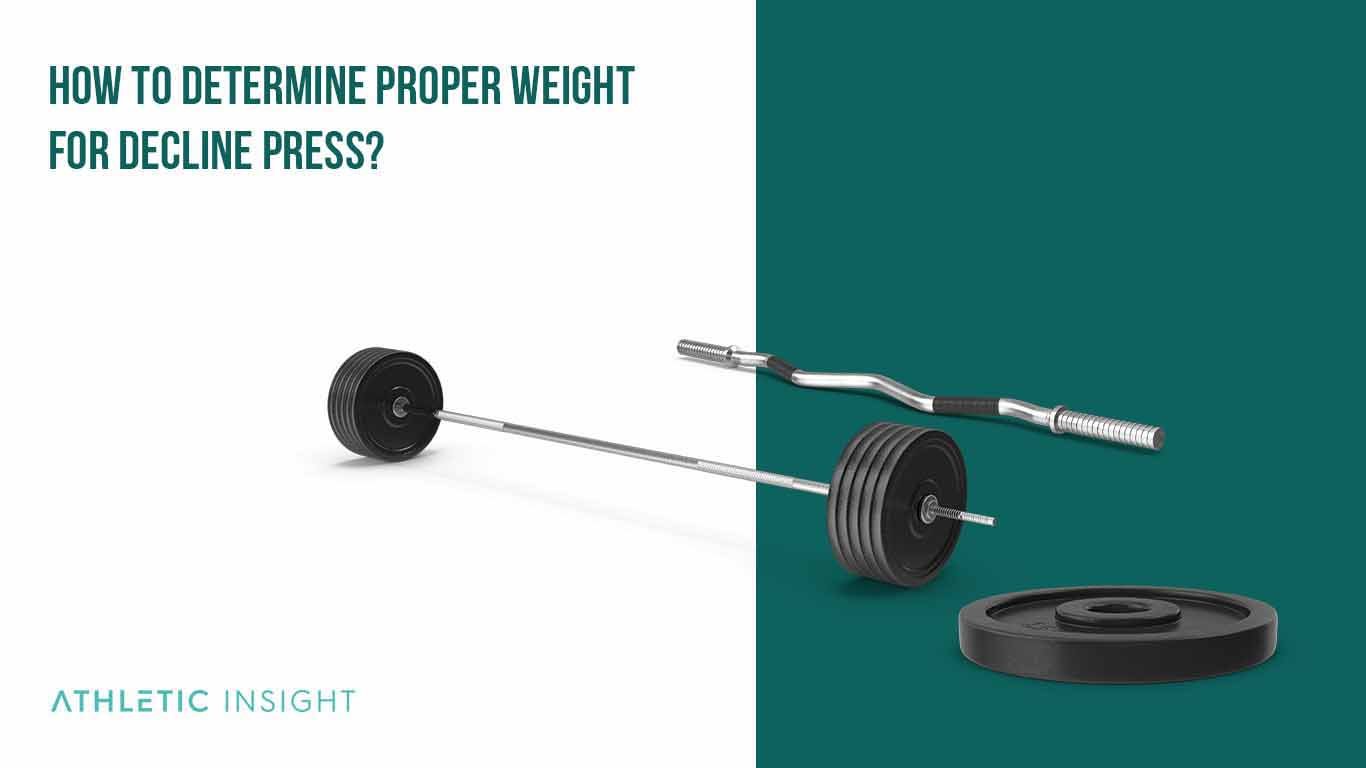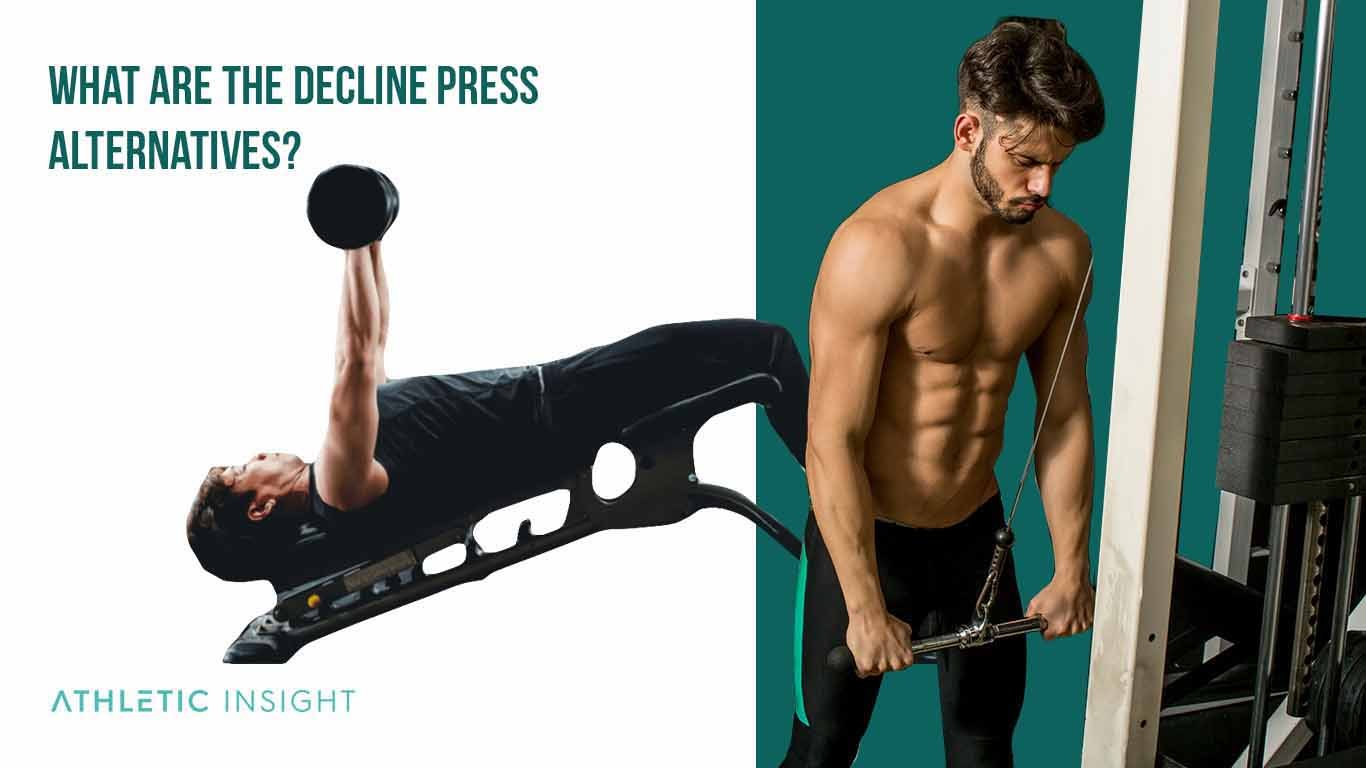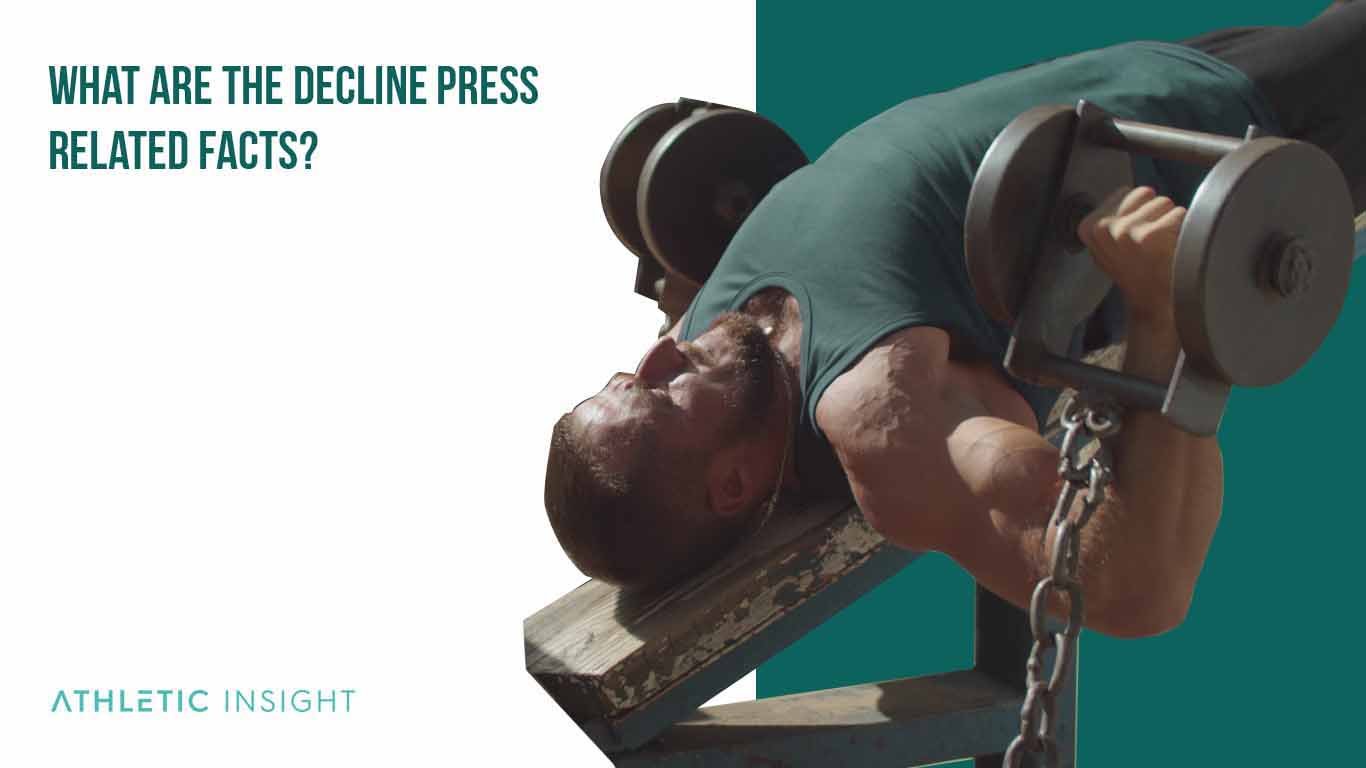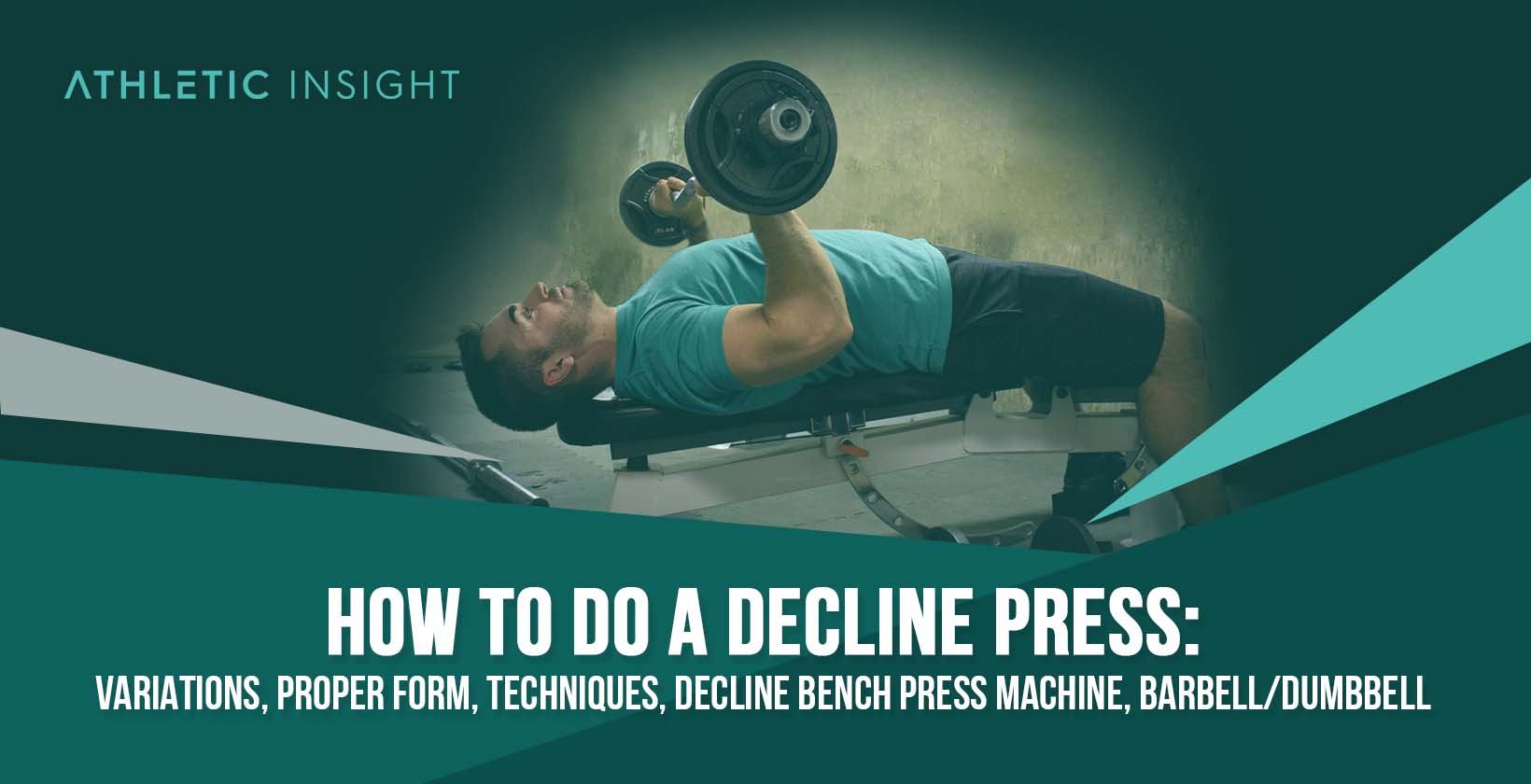A decline press is a variation of the flat bench press that can be used with either a machine, barbell or two dumbbells. The decline of the bench taxes your pectoral muscles and shoulder muscles to a different extent than you would find with an incline press or flat bench press.
The benefits of the decline press include the following.
- An increased activation level of your lower pectoral muscles.
- Tricep activation of the back of your arms.
- Reduced stress and strain on your lower back.
- Lower stress on your shoulder muscles.
- Ability to use heavier weights.
- Improved power transfer to your upper body.
The muscles used in the decline press include the lower pectoral muscles, triceps brachii on the back of the arms, the deltoids, and the biceps brachii on the front side of the arm.
Proper decline bench press bench form is crucial to avoiding injury and strengthening your muscles and joints. Proper decline press form involves gripping your bar with arms slightly wider than your shoulders, straightening your arms to lift the barbell off the rack position, locking out your elbows, lowering the barbell to your mid-chest, keeping your elbows at a 45-degree angle, and pushing your elbows to lockout at the top.
The main decline press types include a decline dumbbell press, decline dumbbell together press, decline dumbbell flyes, single dumbbell pullover, flat bench press, or incline bench press.
The main decline press mistakes are the bar bouncing off the chest, the lower back arching, using too heavy a weight, improper breathing, and not locking out the elbows at the top of the movement. These mistakes can lead to very common injuries such as shoulder impingement, pectoral muscle strain, and lower back strain.
How to Perform Decline Press with Proper Form?
Proper form is performing an exercise safely to get the full benefits while also avoiding injury. Performing the decline press correctly is no different than any other chest exercise. Simply follow the steps below and you’ll be good to go.
- Put your feet at the bench’s end.
- Position yourself behind the barbell.
- Hold the bar with your hands in front of you.
- Keep your arms shoulder-width apart.
- Straighten your arms to lift the barbell.
- Do not lock elbows.
- Inhale and slowly lower the barbell to your mid-chest.
- Put your Elbows at 45 degrees apart. Pause.
- Exhale as you raise the barbell to the starting position. Pause.
- Perform 12 repetitions.
- Place the barbell back on the rack.
- Repeat 3–5 times for a total of 3–5 sets.
What Are the Mistakes for Decline Press Form?
The mistakes that are common for decline press form include not lifting the bar safely off the rack, bouncing the bar off the chest, and not breathing correctly. Individuals need to avoid these mistakes to master good decline press mistakes form and strengthen the pectoral muscles, deltoid, biceps, and triceps.
How to Determine Proper Weight for Decline Press?
Individuals can determine the proper weight for the decline press by analyzing their incline press weight, flat bench weight, and dumbbell chest press weight. Beginner female weight for decline press may be in the range of 35 to 40 pounds, and beginner male weight for decline press may be around 120 pounds.

Which Muscles are Involved While Performing Decline Press?
The main muscles involved in the decline press include the pectoral muscles, deltoids, biceps, and triceps. The muscles worked primarily in this exercise are the pectoral muscles, specifically the lower pectoral muscles.
How to Do Decline Press?
Individuals need to learn how to dominate the decline press before they can perform this exercise regularly. By learning the proper form of the decline press, individuals can increase their bench press weight, overhead press weight, and incline press weight.
What Are the Decline Press Alternatives?
The decline press alternatives are other exercises that tax the same muscle group and can perform similar benefits to the original decline press.

- Decline Dumbbell Bench Press – This exercise is identical to the decline barbell bench press but uses two dumbbells instead of one weight.
- Decline Dumbbell Flyes – Decline flyes use two dumbbells to tax the sides of the pectoral muscles during the eccentric and concentric portions.
- Decline Dumbbell Together Press – The dumbbell together press keeps the dumbbells pressed together to tax a different part of the pectorals.
- Single Dumbbell Serratus Pullover – The pullover exercise works your latissimus pectoralis major and triceps.
- Decline Machine Press – The decline machine press is safer for those who cannot control the barbell and need to use machine weight on a pre-set track.
- Decline Floor Press – The decline floor press involves being on a bridge while using a barbell or dumbbells to perform the chest press motion.
- Incline Push-Up With Underhand Grip – The incline pushup is a bodyweight movement that can help beginners strengthen their shoulders.
- Straight Bar Serratus Pull Down – The pulldown strengthens the serratus and latissimus dorsi on the cable machine.
- High to Low Cable Fly – The high to low cable fly taxes the chest to a higher degree than the shoulders or triceps.
- Vertical Dip With Forward Torso Lean – This exercise strengthens your triceps and pectorals.
What Is the Origin of Decline Press?
The bench press became popular in the late 1950s when it overtook the dip in popularity among weightlifters.
Who Named the Decline Press?
As lifters began to use the bench press and decline press instead of push-ups and dips for chest growth, lifters like George Hackenschmidt drew attention to his chest-building exercise.
Which Muscles Can be Affected More From Decline Press?
The decline press focuses on growing the sternal head and lower head of the pectoralis major instead of the other chest muscles.
What Is the Effectiveness of Decline Press for Muscle Growth When Compared to Squad?
The decline press focuses on the lower pectorals more than the incline or flat bench press, which leads to the muscle growth and activation of the lower pectoral muscles.
What Are the Decline Press Related Facts?
There are numerous decline press-related facts that can influence your decision to use this in your exercise routine.

- The decline press focuses on the lower chest muscles vs. upper chest muscles.
- The decline press activates both the upper and lower pecs, unlike other chest-press motions.
- The decline press is less utilized than the flat bench press
Does Decline Press Affect the Hormones?
The decline press is a compound exercise that increases epinephrine, norepinephrine, testosterone, and HGH.
Does Decline Press Increase Testosterone?
The decline press increases testosterone by including multiple muscle groups and using resistance.
Does Decline Press Affect the Mood?
The decline press affects the mood by increasing serotonin with exercise.
Is Decline Press Practiced Within Crossfit?
The decline press is not practiced within Crossfit but can be used to help with movements such as overhead pressing and pushups.
Is Decline Press a Military Movement?
The decline press is not a military movement but can be used to help with the bench press and overhead press, which are military movements.
Is Decline Press Dangerous?
The decline press is not dangerous if performed correctly with safety.
Is Decline Press Push or Pull?
The decline press is a push exercise since the chest muscles are moving concentrically and contracting during the motion.
Is Decline Press Essential?
The decline press is essential to pectoral and lower pectoral growth and activation to help with chest strength, shoulder mobility, and stability.



